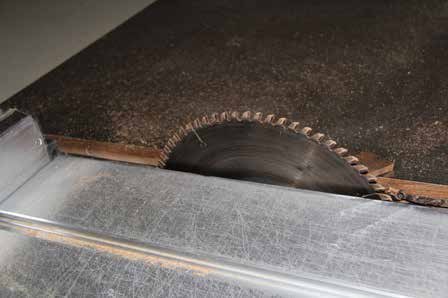The Mantra for perfect planning : The 3 Ps –
While I was reading an article in TOI, I came across the lines from author and life coach Satish Rao saying “People in India only approach experts for help once the tail is on fire, ie., when stress related disorders starts affecting their well-being or productivity”. This gave me the germ to write this article as I was recollecting the discussion I had with my clients and friends from woodworking field.
Whenever I am exchanging views with furniture manufacturers, it has been told to me that the overall state of affairs is very sad with lot of tension, competition, dependence on skilled workers and falling profit levels coupled with lot of troubles in recovering the payments etc. I have shortlisted the three important aspects that will make the furniture manufacturers life easy and tension free.
Planning seems to playing a very important role in running a factory smoothly. Just planning on papers, buying of machines is not enough to run a factory tension free but implementing the real essence of planning correctly and efficiently is needed.
The Mantra for perfect planning: The 3 Ps are, Planning correctly, Productivity optimization and Profit boosting, that will help you in managing your factory without any stresses.
During regular consultation for factories and in following their state of working I came out with some shocking outcomes that surprised me as how factories are prone to fall in trap of similar set of blunders even though investing huge amount of time, money and energies. Many of the factories were 2-3 years old but still struggling to achieve reasonable level of profits. For them every working day is full of problems in spite of investing millions of Rupees in the factory setup.
Most of the factories have almost the same work culture – They possesse high-tech machines but maintain the machines poorly ,and in spite of automatic machines purchased, a lot of manual work is regularly done by semi -skilled workers.
This work culture hampers the output and surface finish of the product. It is a pity that in spite of high-tech machines from best brands the factory is at the mercy of the skills of the workers. There are many equipments available that will eliminate the requirement of manual skills of the workers but neither the supplier not the user is aware of it and we see bulk part of total production as in form of shoddy manual work everywhere done at a slow pace resulting in lower quantity of output.
This is the scenario that inspired me to compile the concept of 3P that will help the industry to come out of the sechronic problems and produce International Quality Product on a big scale. If one takes following 3P seriously than there is no reason why one should suffer such major hurdles in running the factory.
The FIRST P
PLANNING CORRECTLY:
Planning correctly: Planning does not mean only studying the manufacturing process theoretically and buying machines. One has to study each and every operation involved in the manufacturing of any product, small or big, minutely and select the equipment and tooling accordingly. It is pity that in many cases it is observed that results in poor finish.
We will consider one operation “Cutting” for example.
a] Selection of Panel Saw and maintenance of Saw Blades
The first and foremost machine required is a Panel saw and there are many brands available in the market. What I have observed is that there is a misconception that buying a good machine will solve all the problems. It should be understood that the machine does not cut the board, it is the saw blade that cuts the board and it should be rightly selected and maintained properly sharp.
It was observed that most of factories use wrong saw blades with teeth more than 94 teeth up to 104 teeth. This generates more heat and accumulates dust causing burning marks. Normally one should use 60 to 80 teeth for 18 mm for chipboard cutting. Second point was the re-sharpening of the blades. It was observed that the blade thickness changes after sharpening causing imbalance resulting ultimately in vibrations and rough cutting etc. If sharpening is not done accurately then only few teeth will do the cutting and other teeth will be just moving along.

The other important aspect is how much the blade should protrude above the board while cutting. Very few factories are aware of this setting. This resulting in burning marks on the product .
b ] Dust free Edge banding
The Edge banding is the second important operation in the process. It is observed that often the composition of the machines selected is wrong. This results ina variety of unwanted work that results in great loss of time, quality and money. For example I have seen a clean board that had become dirty while processing and many people were employed to clean it with Diesel / kerosene. It was seen that dirt was not removed but spread on more area making it more dirty. The factory staff and bosses were surprised to see the difference between the board before and after edge banding.

It is also observed in many factories that some machines are of very high quality and brand but on the other side they are using very crude methods to process the product resulting in a poor quality and finish. There is no co-relation between quality and the output of the machines. This results in extreme imbalance and fiasco.

We can observe that if Correct Planning of Each operation is done precisely one can avoid such mistakes and produce an international quality product with smooth surface finish .
The second P
Productivity Optimization:
Productivity is directly linked with the quantity & quality of output which is derived from each and every operation that is involved in producing the furniture, however small part of work it may be. One should not look for just getting out put from the machine but should look for quality and good finished product. Balancing of operation plays a vital role in getting desired production. We normally see in factories that some machines are overloaded where as other machines are lying idle and also lot of manual work is done in completing the job. This situation occurs because the composition of machines selected is wrong.
It should be our motto to perform each of the operation on any machine perfectly without any defects. Any deviation from this will involve lot of manual work affecting the productivity& quality. I have observed in many factories that one operation on a machine is giving rise to a number of unwanted manual work that will not only cost money and time but will drop down the productivity to bare minimum level . This is illustrated in the pictures below.

In the above picture we observe that the factory has a very good and expensive edge-banding machine but the output was of very poor quality because of the dirty copying wheel. This resulted in to a rough finish that ultimately needed further three major time consuming manual works. One was manual trimming as is shown in the following picture.

Apart from this the other work needed was the cleaning of the panel due to excess glue and stain marks on the panel made during the processing. Third one was to do buffing on the edges, as the edge had becomematt due to scrapping. The buffing was necessary to bring shine on the edges making it look good at last.
Spindle molder is one of the most important machine in furniture factory. It is seen many times that crude methods are used to do the setting of the tool even though accessories are supplied with the machine which are provided to ease the setting of tool. Special accessories are also available that ease the setting and that too more accurately and quickly. In the following picture we see that wooden parts are made to make

the working easy and safe. This crude way of setting not only needs a skilled worker to set the tool on Spindle Molder, but also it is risky for safety of operator and also it is prone for kickback of the work piece. It is unfortunate that the user is not aware of the fixtures available that will ease the working and supplier is also not able to guide about the accurate and safe use. With right accessories &jigs the spindle molder is safest and the King of machines on the floor as it can shape& profile the components with least efforts – with minimum investment and with no risk.
The THIRD P
Profit boosting:
Every factory is keen to boost the profits. But it is not an easytask. Profit boosting needs devoted and sustained efforts to achievethe grand results. Just buying machines and tools will not help in achieving this Ultimate Goal. The product mix should be such that one has to go closer to 80:20 formulas. This means that 80% of your output should result in 20% of the profits and 20% of the output should result in to 80% profits. To achieve this one should have two ranges of products. One product range should be for the larger section of the market – that goes for mass consumption and other should be for the Top End market which needs High End designer products.
It was always asked to me that in spite of buying the same European branded machine and in spite of using the best raw material &hardware why our product finish does not match with Italian or German furniture products.
The simple reason is the lack of 3 Ps, Planning correctly, Productivity optimization and Profit boosting.

If you aspire to make beautiful furniture or if you look forward to get your manufacturing process audited then please contact the author:
Shanti Mansabdar
Email: shanti@woodconconsultants.com
For details visit: www.woodconconsultants.com

